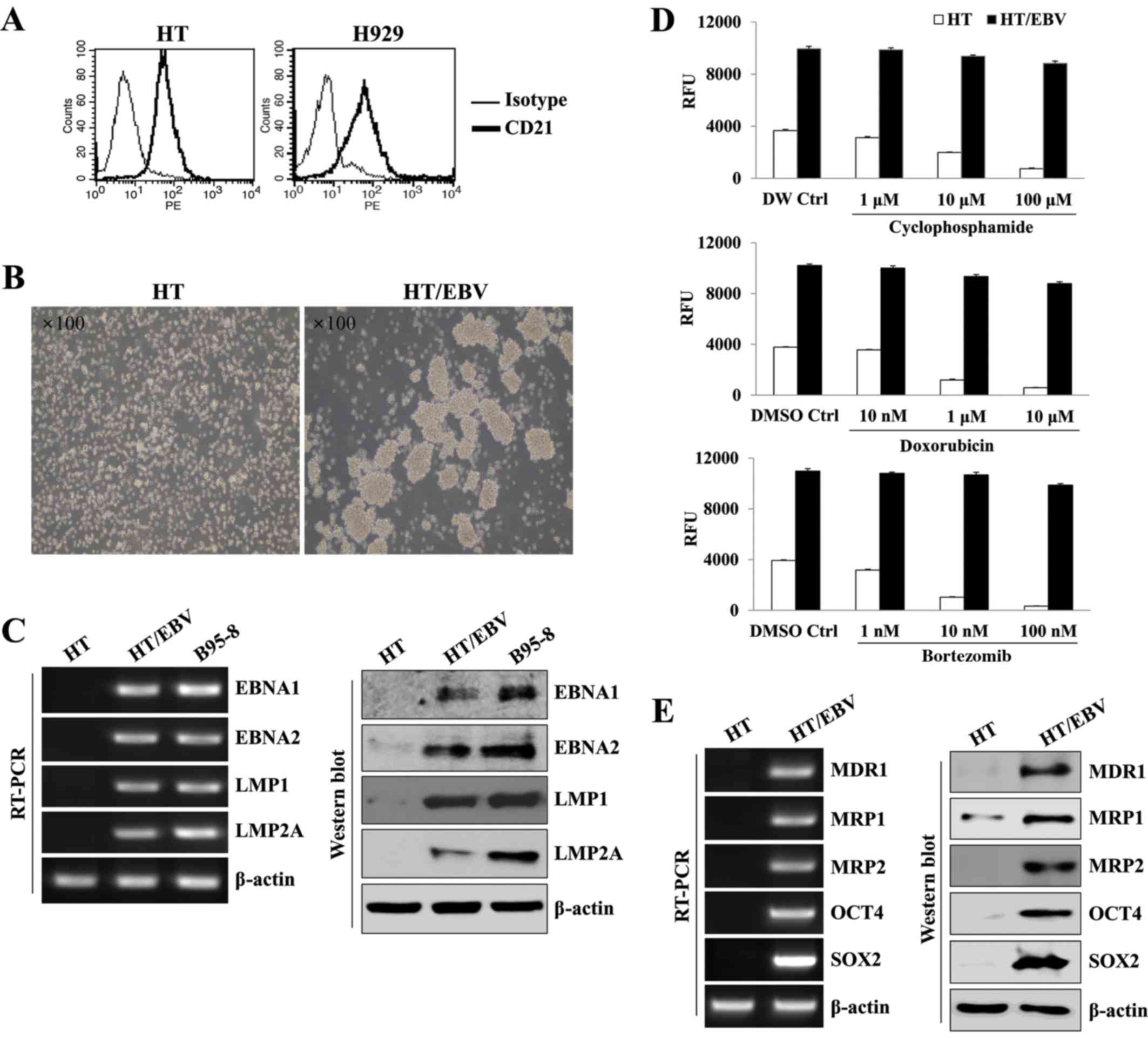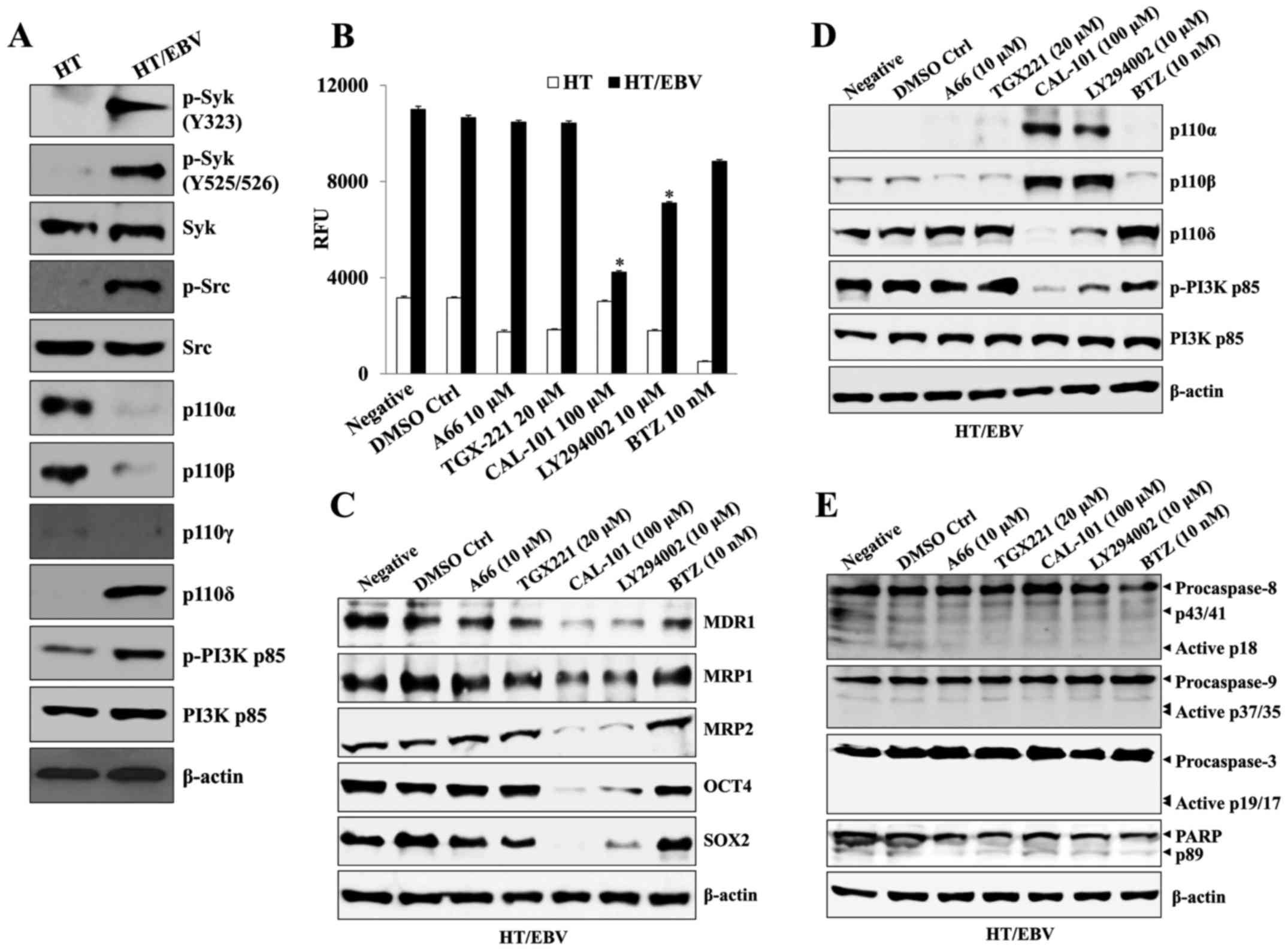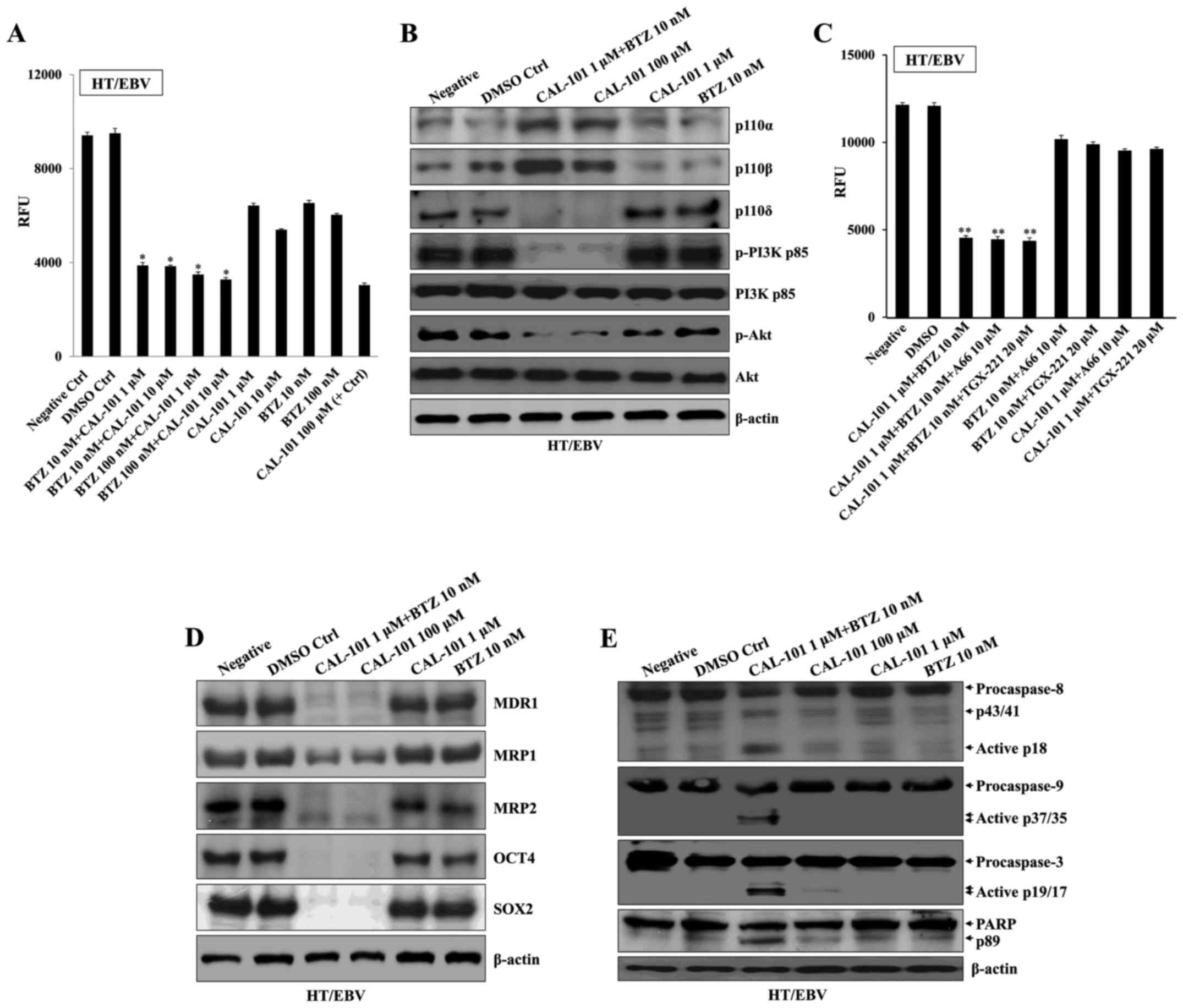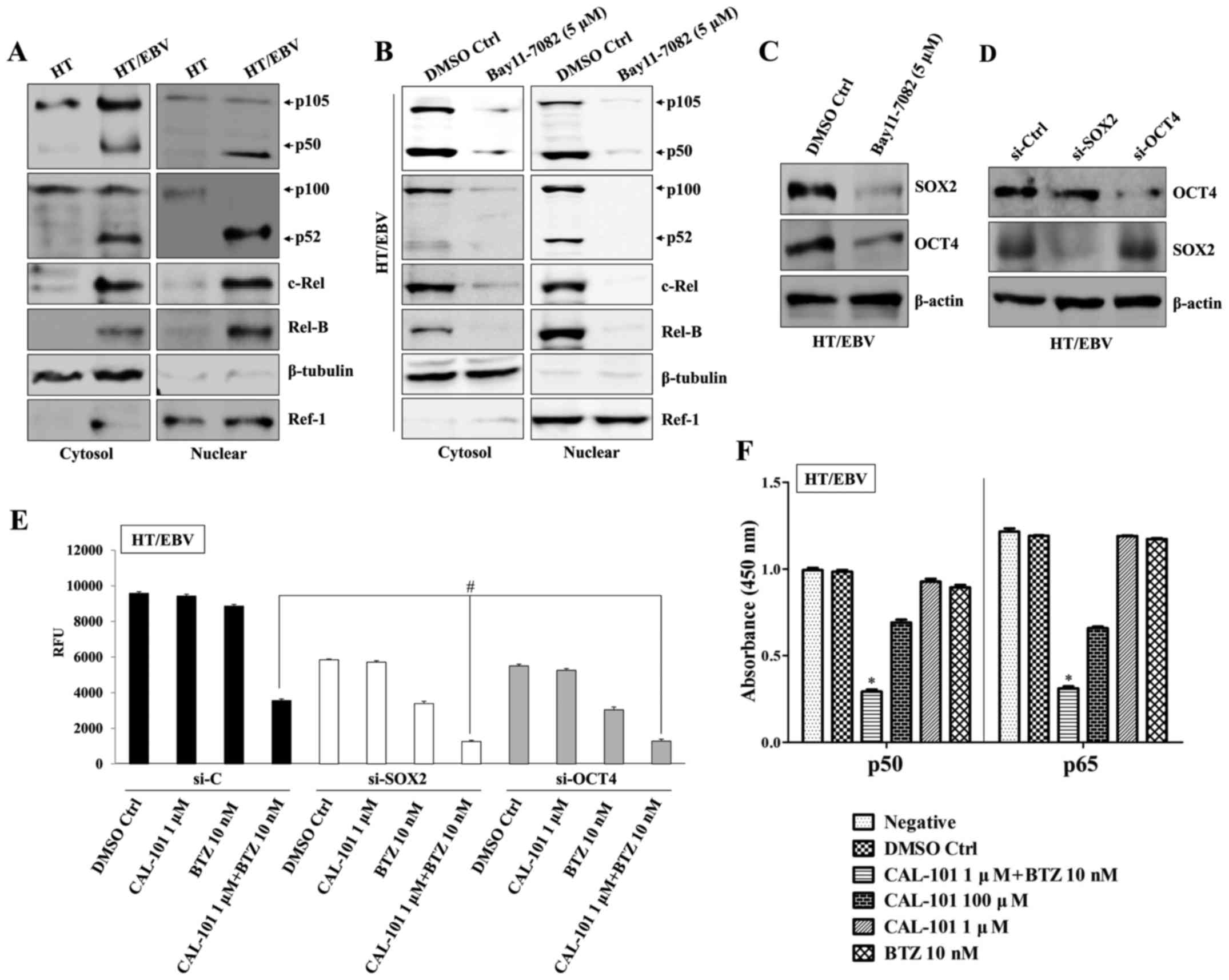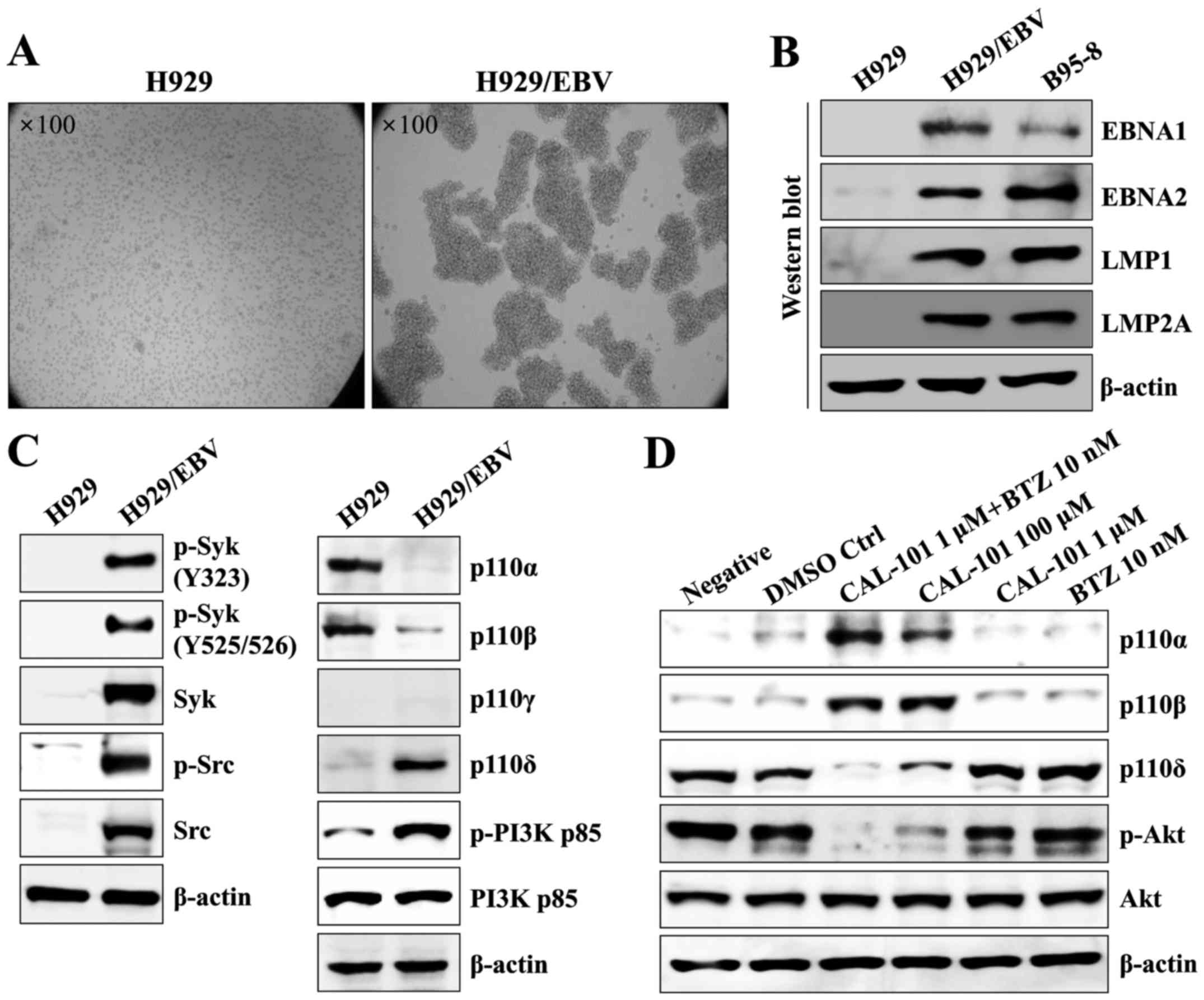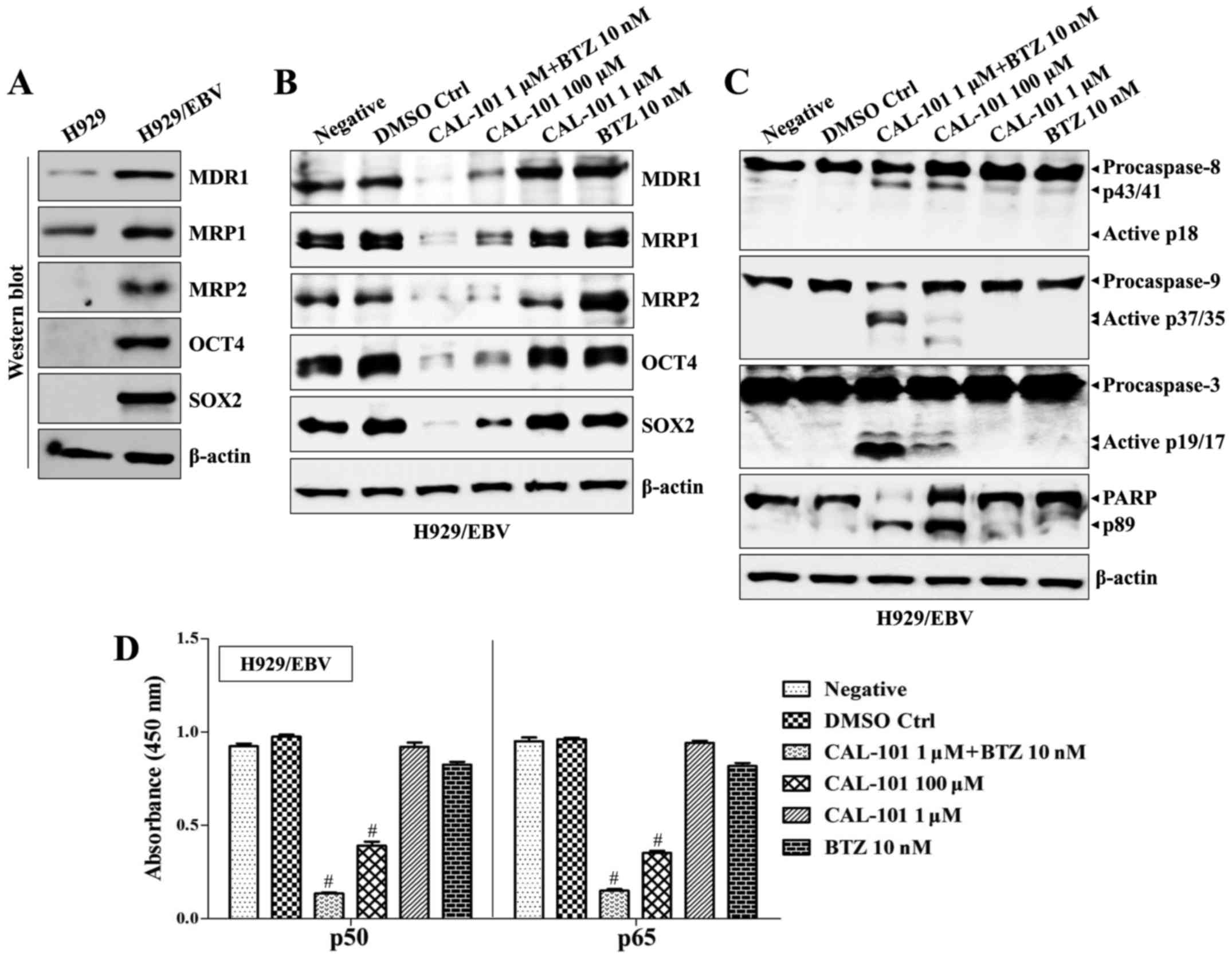A p110δ-specific inhibitor combined with bortezomib blocks drug resistance properties of EBV-related B cell origin cancer cells via regulation of NF-κB
- Authors:
- Published online on: March 21, 2017 https://doi.org/10.3892/ijo.2017.3923
- Pages: 1711-1720
Abstract
Introduction
Diffuse large B-cell lymphoma (DLBCL) is the most common subtype of non-Hodgkin lymphoma (NHL) and accounts for ~30–40% of all newly diagnosed lymphomas among adults (1,2). DLBCL is readily curable with combination chemotherapy, such as R-CHOP (rituximab, cyclophosphamide, adriamycin, vincristine and prednisone) (3,4). Although ~50% of patients with diffuse large B-cell lymphoma can now survive for more than 10 years (5), most patients who do not respond to R-CHOP treatment will eventually die from the disease. As a result, efforts have focused on the development of a more effective and personalized treatment modality.
EBV is associated with a number of malignancies, such as nasopharyngeal carcinoma, NHL and a subset of B-cell lymphoma in immunosuppressed individuals (6). EBV-positive DLBCL in patients older than 50 years is not associated with any known immunodeficiency (7). In addition, EBV-positive DLBCL in the elderly is characterized by activated B-cell phenotypes via NF-κB pathway activation and high expression of latent membrane protein 1 (LMP1) (8). EBV-LMP1 not only activates phosphatidylinositol 3-kinase (PI3K)/Akt pathways (9,10), but also is associated with the development of cancer stem cells (CSC) in nasopharyngeal epithelial cell lines (30). LMP1 also increases the expression of several markers, such as Octamer 4 (OCT4), SRY-related HMG box 2 (SOX2) and ATP-binding cassette (ABC) subfamily G member 2 (ABCG2) (11). The three major multidrug resistance ABC transporter proteins consist of multidrug resistance-related protein-1 (MRP1), multidrug resistance 1 (MDR1; P-glycoprotein) and ABCG2 (12). These proteins specifically allow the transport of various chemical entities, including anticancer drugs (13,14). ABC transporters are also a major route for anthracycline (e.g., adriamycin) elimination (3). Furthermore, the complete remission rates are significantly lower in the group expressing drug resistance-related proteins than in the group not expressing them (15). These results demonstrate that the increased expression of ABC transporters on plasma membranes results in increased efflux of anticancer drugs, leading to multidrug resistance. However, detailed downstream signaling and the role of PI3K in induction of ABC transporters and survival of EBV-infected B cell cancer are not clear.
B-cell receptor (BCR) ligation activates CD19-related Src family kinases (Lyn, Fyn and Blk) and Syk tyrosine kinase, leading to Lyn- or Syk-dependent phosphoinositide 3-kinase (PI3K) activation (16–18). Several types of B cell malignancies appear to be dependent on the PI3K pathway for survival (19,20). PI3K signaling, especially constitutive expression of p110α, is associated with survival of multiple myeloma (MM) cells (21). Knockdown of p110δ, a PI3K catalytic unit, by small interfering RNA also causes significant inhibition of MM cell growth (22), whereas inhibitors of the p110δ catalytic isoform (idelalisib) fail to suppress aggressive DLBCL (23,24). Furthermore, the catalytic subunit of PI3K association with drug resistance in DLCBL remains unknown.
In the present study, we established EBV-infected DLBCL and MM cell lines as in vitro models to characterize EBV-induced drug resistance and identify molecular targets to control refractory B cell cancer. Bortezomib, which is approved for treatment of MM, reduced the level of p50 and p65 components of the canonical NF-κB pathway in EBV-transformed B cells and reduced the level of p52 in the non-canonical NF-κB pathway (25). We also investigated whether a combination of the PI3K inhibitor and bortezomib controls characteristics of EBV-related B cell cancer by blocking NF-κB activity.
Materials and methods
Preparation of EBV infectious culture supernatant and generation of EBV-infected DLBCL and MM cells
EBV supernatant stock was prepared from a B95–8 cell line (Vircell S.L., Granada, Spain). DLBCL or MM cells were added to EBV stock supernatant, and after 2-h incubation at 37°C, RPMI-1640 media (Corning Inc., Corning, NY, USA) was added (1×106 cells/ml). The cultures were incubated for 3 weeks. Analysis of surface expression of CD21 was verified by BD Accuri™ C6 (BD Biosciences, San Jose, CA, USA) using PE-conjugated anti-CD21 antibody (BD Biosciences).
Cell lines and reagents
HT cell lines were obtained from the American Type Culture Collection (ATCC; Manassas, VA, USA). NCI-H929 cell lines were obtained from the European Collection of Cell Cultures (ECACC; Salisbury, UK). These cells were maintained in RPMI-1640 media (Corning) supplemented with 10% fetal bovine serum (FBS; RMBIO, Missoula, MT, USA), streptomycin and glutamine at 37°C in 5% CO2. Bortezomib was purchased from LC Laboratories (Woburn, MA, USA). Doxorubicin and cyclophosphamide were obtained from Sigma-Aldrich (St. Louis, MO, USA). Bay11-7082, A66, TGX-221, CAL-101 and LY294002 were purchased from Selleck Chemicals (Houston, TX, USA).
Cell proliferation assay
Cells (5×104 cells/well) were cultured in media containing 10% FBS in 96-well plates. After 24 h, cell proliferation was measured using an AlamarBlue (Serotec Ltd., Kidlington, Oxford, UK) assay. AlamarBlue was added (10% by volume) to each well, and relative fluorescence units (RFUs) were determined 9 h later with a Wallac 1420 Victor2 multi-label plate reader (Perkin-Elmer, Shelton, CT, USA; excitation, 530 nm; emission, 590 nm). Experiments were performed in triplicate, and relative fluorescence was calculated using mean fluorescence for each culture.
RT-PCR
Total RNA was isolated using an RNeasy Mini kit (Qiagen, Hilden, Germany) and transcribed into cDNA using oligo (dT) primers and reverse transcriptase. PCR products were amplified using specific primer sets for EBNA1 (upstream primer, 5′-GAGCGGGGAGATAATGTACA; downstream primer, 5′-TAAAAGATGGCCGGACAAGG), EBNA2 (upstream primer, 5′-AACCCTCTAAGACTCAAGGC; downstream primer, 5′-ACTTTCGTCTAAGTCTGCGG), LMP1 (upstream primer, 5′-CACGACCTTGAGAGGGGCCCA; downstream primer, 5′-GCCAGATGGTGGCACCAAGTC), LMP2A (upstream primer, 5′-ATGACTCATCTCAACACATA; downstream primer, 5′-CATGTTAGGCAAATTGCAAA), MDR1 (upstream primer, 5′-TTGCTGCTTACATTCAGGTTTCA; downstream primer, 5′-AGCCTATCTCCTGT GCATTA), MRP1 (upstream primer, 5′-AAGACCAAGACGTATCAGGT; downstream primer, 5′-CAATGGTCACGTAGACGGCAA), MRP2 (upstream primer, 5′-TCTCTCGATACTCTGTGGCAC; downstream primer, 5′-CTGGAATCCGTAGGAGATGAAGA), OCT4 (upstream primer, 5′-CGACCATCTGCCGCTTTGAG; downstream primer, 5′-CCCCCTGTCCCCCATTCCTA), and SOX2 (upstream primer, 5′-AGCAACGGCAGCTACAGCA; downstream primer, 5′-TGGGAGGAAGAGGTAACCACAG). A specific primer set for β-actin (upstream primer, 5′-ATCCACGAAACTACCTTCAA; downstream primer, 5′-ATCCACACGGAGTACTTGC) was used as a control, and PCR was performed using Prime Taq Premix (GeNet Bio, Chungnam, Korea). PCR products were analyzed via agarose gel electrophoresis and visualized with ethidium bromide under UV light using the Amersham™ Image 600 (GE Healthcare, Pittsburgh, PA, USA).
Western blot analysis
Cells were harvested and lysed in radioimmunoprecipitation assay (RIPA) buffer (Elpis Biotech, Inc., Daejeon, Korea) containing a protease inhibitor cocktail (Sigma-Aldrich) and phosphatase inhibitor (Cocktail II; Sigma-Aldrich). Total cell lysates were subjected to SDS-PAGE. Separated proteins were transferred to nitrocellulose membranes (Millipore, Billerica, MA, USA), the membranes were blocked with 5% skim milk, and conventional immunoblotting was performed using several antibodies. Chemiluminescence was detected using an ECL kit (Advansta Inc., Menlo Park, CA, USA) and the Amersham™ Image 600 (GE Healthcare). The following primary Abs were used: MDR1, MRP1, MRP2, OCT4, SOX2, phospho-Src (Tyr416), Src, phospho-Syk (Tyr323), phospho-Syk (Tyr525/526), Syk, p110α, p110β, p110γ, p110δ, phospho-PI3K (Tyr458), PI3K, phospho-Akt (Ser473), Akt, phospho-Akt (Ser473), caspase-8, caspase-9, caspase-3, PARP, NF-κB p105/p50, p100/p52, c-Rel, Rel-B and β-actin were obtained from Cell Signaling Technology (Beverly, MA, USA); EBNA2, LMP2A and Ref-1 were obtained from Santa Cruz Biotechnology (Santa Cruz, CA, USA); β-tubulin was obtained from BD Biosciences; LMP1 was obtained from Abnova (Taipei, Taiwan); and EBNA1 was obtained from Thermo Fisher Scientific (Rockford, IL, USA).
Small interfering RNA (siRNA) transfection
Experimentally verified human SOX2-siRNA duplex, OCT4-siRNA duplex, and negative control-siRNA were obtained from Bioneer. Cells were seeded at a concentration of 1×106/well in a 6-well plate and grown overnight prior to transfection with 300 nM siRNA using Viromer Blue reagent (Lipocalyx GmbH, Halle, Germany) according to the manufacturer's instructions. Cells were used for further experiments 48 h after transfection.
Detection of NF-κB translocation by fractionation
Nuclear and cytosol cellular fractions were prepared using a Nuclear/Cytosol Fractionation kit (BioVision Inc., Mountain View, CA, USA), according to the manufacturer's protocol. Briefly, 2×106 cells with or without various treatments were harvested and suspended in 200 µl of cytosol extraction buffer A. After incubation on ice for 10 min, cytosol extraction buffer B was added to the cell suspension and incubated on ice for 1 min. The obtained pellets were re-suspended in 10 µl of nuclear extraction buffer mix and designated nuclear fractions.
Measurement of NF-κB activity by NF-κB DNA-binding ELISA
ELISA and an NF-κB p50/p65 Transcription Factor assay kit (Abcam, Cambridge, MA, USA) were used according to the manufacturer's protocol to quantify the DNA-binding activity of NF-κB. Briefly, nuclear extracts were transferred to a 96-well plate coated with a specific dsDNA sequence containing the NF-κB response element. NF-κB proteins bound to the target sequence were detected with a primary antibody and an HRP-conjugated secondary antibody. Absorbance was measured at 450 nm as a relative measure of protein-bound NF-κB. All fractions were stored at −80°C until further use.
Statistical analysis
Data are expressed as mean ± standard deviation (SD). Statistical analysis was conducted using one-way analysis of the variance (ANOVA). P<0.05 were considered statistically significant.
Results
EBV infection is capable of inducing drug resistance in DLBCL cells
To establish EBV-transformed DLBCL and MM as a model of EBV-related drug resistant B cell cancer, we first examined the expression of CD21, a receptor for cellular infection of EBV, in HT and H929 cell lines. HT and H929 had stable expression of CD21 (Fig. 1A). In addition, HT cells showed characteristic cluster formation and rapid proliferation at 3 weeks after EBV infection (Fig. 1B). At 5 weeks, EBV-infected HT (HT/EBV) cells expressed and maintained EBV-related mRNA and proteins (EBNA1, EBNA2, LMP1 and LMP2A) and levels similar to the protein expression observed in B95-8 cells (Fig. 1C). EBV-infected HT cells also exhibited drug resistance to several approved drugs, including cyclophosphamide, doxorubicin and bortezomib (Fig. 1D). HT/EBV cells upregulated the expression of MDR1, MRP1, MRP2 and stem cell markers, including OCT4 and SOX2 (Fig. 1E). These results suggest that HT/EBV cells display relatively high drug resistance compared with non-infected HT cells.
Syk/Src-mediated p110δ/Akt pathway induces drug resistance in HT/EBV cells
Next, we investigated which p110 isoform is associated with the generation of chemoresistant cells after EBV infection using each inhibitor of the p110 isoform of PI3K. EBV-infected HT cells had enhanced expression of phosphorylated Syk/Src kinase and p110δ compared to that of non-infected HT cells, whereas p110α and p110β activation were significantly inhibited after EBV infection (Fig. 2A). Although treatment with bortezomib resulted in the most effective anti-proliferative action against non-infected HT cells (Fig. 2B), specific inhibitors of p110α and p110β also significantly inhibited the proliferation of non-infected HT cells (Fig. 2B). Whereas, A66 (p110α inhibitor) and TGX-221 (p110β inhibitor) had no effect on the proliferation rate of HT/EBV cells (Fig. 2B), but CAL-101 (a specific inhibitor of p110δ) or LY294002 (p110α/β/δ inhibitor) significantly reduced the growth rate of HT/EBV cells (Fig. 2B). The treatment with CAL-101 or LY294002 of HT/EBV cells suppressed the appearance of drug resistance-related proteins (Fig. 2C) and re-induced the expression of p110α and p110β, whereas the level of p110δ was suppressed (Fig. 2D). However, treatment with high doses of CAL-101 or bortezomib alone had no effect on the cleavage of caspase-9 and -3 in H929/EBV cells (Fig. 2E). These results suggest that the activation of the p110δ isotype of PI3K results in drug resistance and the expression of p110δ has a critical role in the development of drug-resistant cancer cells after EBV infection.
Combination of a p110δ inhibitor with bortezomib induces cell death and reverses the characteristics of HT/EBV cells
Next, we examined whether CAL-101 combined with bortezomib prevents proliferation and induces cell death of HT/EBV cells. Co-treatment of HT/EBV cells with CAL-101 (1 µM) and bortezomib (10 nM) effectively inhibited proliferation compared with high doses of CAL-101 (100 µM) or bortezomib (100 nM) alone (Fig. 3A). CAL-101 combined with bortezomib prominently restored the expression of p110α and p110β as well as suppression of p110δ activation in HT/EBV cells (Fig. 3B). However, additional combination with A66 or TGX-221 failed to further inhibit the proliferation of HT/EBV cells (Fig. 3C). The expression of MDR1, MRP1, MRP2 and stem cell markers in H929/EBV cells was completely reversed after treatment with CAL-101 and bortezomib (Fig. 3D). In addition, combining CAL-101 with bortezomib activated caspase-9 and -3 synergistically and resulted in cleaved PARP, the target of activated caspase-3 (Fig. 3E). These results suggest that CAL-101 and bortezomib synergistically converted the intractable DLBCL infected by EBV into treatable DLBCL cells.
Combining CAL-101 and bortezomib reverses drug resistance through blockage of NF-κB activation
B-cell-related cancer cells promote downstream signaling through the PI3K and NF-κB pathways for survival and proliferation (26,27). Inhibition of canonical NF-κB signaling leads to apoptosis and suppression of OCT4 expression (28). We next investigated whether co-treatment with CAL-101 and bortezomib affects the expression of SOX2 and OCT4 via regulation of NF-κB activity. Treatment with an NF-κB inhibitor (Bay-11-7082) resulted in inhibition of activation and nuclear translocation of key components p50, p52 and Rel-B of NF-κB (Fig. 4A and B) in both the cytosol and nuclear fractions of HT/EBV cells and reduced the expression of SOX2 and OCT4 (Fig. 4C). To confirm the direct involvement of OCT4 and SOX2 in drug resistance of HT/EBV cells, OCT4 and SOX2 were silenced with siRNA (Fig. 4D), followed by treatment with CAL-101 and bortezomib in HT/EBV cells. Gene silencing of HT/EBV cells with OCT4 siRNA or SOX2 siRNA effectively suppressed proliferation and increased the sensitivity to bortezomib and co-treatment with CAL-101 and bortezomib (Fig. 4E). In addition, combinational treatment with CAL-101 and bortezomib synergistically attenuated NF-κB activation through inhibition of both canonical (p50) and non-canonical (p65) pathways in H929/EBV cells (Fig. 4F). These results suggest that the p110δ PI3K/NF-κB signaling pathway regulates drug resistance in EBV-infected DLBCL cells.
Suppression of p110δ PI3K and NF-κB activity attenuates drug resistance of EBV-positive MM cells
The EBV genome was also detected in MM (29–31). Furthermore, SOX2 is expressed not only in monoclonal gammopathy of undetermined significance (MGUS), but also in symptomatic MM (11). We next investigated whether co-treatment with CAL-101 and bortezomib blocked the development of drug resistance and generation of stem cell characteristics in EBV-positive MM cells. The H929 cell line, an EBV-negative MM cell line, was infected with EBV, and EBV-infected H929 (H929/EBV) cells generated clumps and showed enhanced proliferation (Fig. 5A). EBV-related mRNAs and proteins were detected in H929/EBV cells at similar levels to those of B95-8 cells (Fig. 5B). Although the expression of p110α/p110β was suppressed, the p110δ isoform of PI3K increased along with upregulation of phosphorylated Syk/Src kinase in H929/EBV cells (Fig. 5C). Treatment with CAL-101 and bortezomib efficiently blocked the elevation of p110δ and restored the expression of p110α/p110β in H929/EBV cells (Fig. 5D). Although H929/EBV cells increased the expression of MDR1, MRP1, MRP2, OCT4 and SOX2 (Fig. 6A), a combination of CAL-101 with bortezomib synergistically suppressed the expression of drug resistance-related proteins and stem cell markers (Fig. 6B) and enhanced the expression of cleaved caspases compared with the group treated with single drugs (Fig. 6C) in H929/EBV cells. Furthermore, co-treatment with CAL-101 and bortezomib of H929/EBV cells blocked the activation of canonical and non-canonical NF-κB (Fig. 6D). These results indicate that co-treatment with CAL-101 and bortezomib has a suppressive effect against EBV-positive MM cells.
Discussion
Although EBV genome-carrying cells represent a small fraction of the total population in various EBV-related cancers (23,25,45), EBV infection resulted in drug resistance in DLBCL and MM cells in the present study. Class I PI3K enzymes expressed in B cells are heterodimeric complexes composed of regulatory (p85) and catalytic (p110α, p110β, p110δ or p110γ) subunits (32). While the p110α and p110β catalytic isoforms are ubiquitously expressed, the p110δ and p110γ isoforms are largely restricted to leukocytes (33,34). The PIK3CA gene, which encodes p110α, is mutated in many cancers, whereas PI3K/AKT mutations are rarely found, especially in B cell malignancies and multiple myeloma (35–37). Although resistance to chemotherapy is acquired through a variety of mechanisms, including activation of key pro-survival signaling molecules, such as PI3K and NF-κB activation (38), the mechanisms underlying aberrant expression and activity of p110δ in EBV-infected cancer cells remain unclear. From these results, we hypothesize that co-treatment with CAL-101 and bortezomib might reduce the resistance to anticancer drugs by synergistic suppression of NF-κB activity. In this study, EBV-infected cancer cells upregulated Syk/Src-dependent p110δ PI3K activation, leading to promotion of the expression of drug resistance-related proteins, including MDR1, MRP1 and MRP2. A combination of CAL-101 with bortezomib attenuated chemoresistance and the expression of stem cell markers by blocking the nuclear translocation and accumulation of NF-κB in EBV-infected DLBCL and MM cells. These results suggest that the regulation of p110δ/Akt-mediated NF-κB pathway plays a critical role in the generation of EBV-induced chemoresistant cancer cells.
EBV-positive DLBCL in the elderly accounts for 8–10% of DLBCL among Asian patients (39). EBV-positive cells are characterized by postgerminal center B-cell phenotypes and prominent NF-κB activation (8). The prognosis of EBNA2-expressing EBV-positive DLBCL patients is significantly worse compared with EBV-negative cases (40). Most studies have also shown that the outcome of elderly patients with EBV-positive DLBCL treated with drug combinations (CHOP) in the presence of rituximab (R-CHOP) is worse than that of patients who are EBV-negative under the same treatment (41–43). MRP1 has been identified in cell lines showing the typical multidrug resistance phenotypes, but without elevated expression of MDR1 (P-glycoprotein) (17). Expression of MDR1 has a significant effect on response to chemotherapy and prognosis in AIDS-related NHL (18). Since MDR1 and MRP1 are key efflux routes of anthracycline, which is one of the key drugs for treatment of DLBCL, we investigated whether blocking p110δ activation has an effect on the expression of drug resistance-related proteins in EBV-infected cancer cells. Treatment with high doses of CAL-101 or LY294002 significantly suppressed proliferation and expression of MDR1, MRP1 and MRP2 in EBV-infected B cell cancer cells. These results suggest that activation of p110δ plays an important role in development of drug resistance induced by EBV infection.
Bortezomib is widely used to treat both newly diagnosed MM and relapsed or refractory MM (44,45). However, bortezomib treatment appears to generate very short-duration responses and results in rapid development of drug resistance (46). Although bortezomib, a proteasome inhibitor, has been found to induce apoptosis in EBV lymphoblastoid cell lines through suppression of canonical and non-canonical activity of NF-κB (25), the effects of bortezomib on the generation of drug resistance in EBV-infected B cell cancer remain controversial. Inhibition of NF-κB activation results in apoptosis and suppression of OCT4 expression in human embryonic stem cells (28). In this study, treatment with bortezomib alone had no effect on levels of SOX2 and OCT4 in EBV-infected DLBCL and MM cells. Notably, our results showed that CAL-101, in combination with bortezomib, suppressed expression of stem cell markers and induced cleavage of caspase-3 via inhibition of NF-κB activation in EBV-infected DLBCL and MM cells. Based on these results, we confirmed that p110δ/Akt-mediated NF-κB activation is an essential pathway in the generation of EBV-related cancer stem cells, and these cells might be converted into drug-sensitive cancer cells after treatment with a combination of CAL-101 and bortezomib.
Multiple myeloma (MM) is characterized by uncontrolled proliferation of plasma cells (PCs) in bone marrow (47). Despite the development of novel targeted drugs, including proteasome inhibitors (bortezomib) and immunomodulatory drugs (thalidomide and lenalidomide), the incidence of MM is expected to increase due to aging populations (48,49). In addition, MM is considered treatable, but not curable, even after bone marrow transplantation (50,51), because this disease eventually results in relapse and becomes hopeless due to the development of high malignancy and resistance to first-line anti-MM drugs (52,53). However, the molecular characteristics of drug-resistant refractory MM and the specific method to convert intractable MM to a treatable condition are still unclear and undefined. Although there is still controversy about MM cancer stem cells and drug-resistant condition, we found that p110δ-dependent NF-κB activation in EBV-infected MM cells is responsible for the development of stem cell characteristics and generation of drug resistance. Our results suggest that the combination of a specific p110δ inhibitor and bortezomib may convert incurable refractory hematologic disease into a manageable condition and that this combination can be used to treat DLBCL in elderly patients and relapsed drug-resistant MM-expressing cancer stem cell markers.
Acknowledgments
This study was supported by the Basic Science Research Program of Ministry of Education (no. NRF-2015R1D1A1A01056672) and the Ministry of Science, ICT and Future Planning (NRF-2015R1C1A2A01053732) through the National Research Foundation (NRF) of Republic of Korea.
References
|
Lenz G and Staudt LM: Aggressive lymphomas. N Engl J Med. 362:1417–1429. 2010. View Article : Google Scholar : PubMed/NCBI | |
|
Klein U and Dalla-Favera R: Germinal centres: Role in B-cell physiology and malignancy. Nat Rev Immunol. 8:22–33. 2008. View Article : Google Scholar | |
|
Andreadis C, Gimotty PA, Wahl P, Hammond R, Houldsworth J, Schuster SJ and Rebbeck TR: Members of the glutathione and ABC-transporter families are associated with clinical outcome in patients with diffuse large B-cell lymphoma. Blood. 109:3409–3416. 2007. View Article : Google Scholar | |
|
Sehn LH and Gascoyne RD: Diffuse large B-cell lymphoma: Optimizing outcome in the context of clinical and biologic heterogeneity. Blood. 125:22–32. 2015. View Article : Google Scholar | |
|
Maurer MJ, Ghesquières H, Jais JP, Witzig TE, Haioun C, Thompson CA, Delarue R, Micallef IN, Peyrade F, Macon WR, et al: Event-free survival at 24 months is a robust end point for disease-related outcome in diffuse large B-cell lymphoma treated with immunochemotherapy. J Clin Oncol. 32:1066–1073. 2014. View Article : Google Scholar : PubMed/NCBI | |
|
Küppers R: B cells under influence: Transformation of B cells by Epstein-Barr virus. Nat Rev Immunol. 3:801–812. 2003. View Article : Google Scholar : PubMed/NCBI | |
|
Ok CY, Papathomas TG, Medeiros LJ and Young KH: EBV-positive diffuse large B-cell lymphoma of the elderly. Blood. 122:328–340. 2013. View Article : Google Scholar : PubMed/NCBI | |
|
Montes-Moreno S, Odqvist L, Diaz-Perez JA, Lopez AB, de Villambrosía SG, Mazorra F, Castillo ME, Lopez M, Pajares R, García JF, et al: EBV-positive diffuse large B-cell lymphoma of the elderly is an aggressive post-germinal center B-cell neoplasm characterized by prominent nuclear factor-κB activation. Mod Pathol. 25:968–982. 2012. View Article : Google Scholar : PubMed/NCBI | |
|
Roberts ML and Cooper NR: Activation of a ras-MAPK-dependent pathway by Epstein-Barr virus latent membrane protein 1 is essential for cellular transformation. Virology. 240:93–99. 1998. View Article : Google Scholar : PubMed/NCBI | |
|
Dawson CW, Tramountanis G, Eliopoulos AG and Young LS: Epstein-Barr virus latent membrane protein 1 (LMP1) activates the phosphatidylinositol 3-kinase/Akt pathway to promote cell survival and induce actin filament remodeling. J Biol Chem. 278:3694–3704. 2003. View Article : Google Scholar | |
|
Kondo S, Wakisaka N, Muramatsu M, Zen Y, Endo K, Murono S, Sugimoto H, Yamaoka S, Pagano JS and Yoshizaki T: Epstein-Barr virus latent membrane protein 1 induces cancer stem/progenitor-like cells in nasopharyngeal epithelial cell lines. J Virol. 85:11255–11264. 2011. View Article : Google Scholar : PubMed/NCBI | |
|
Mo W and Zhang JT: Human ABCG2: Structure, function, and its role in multidrug resistance. Int J Biochem Mol Biol. 3:1–27. 2012.PubMed/NCBI | |
|
Ambudkar SV, Dey S, Hrycyna CA, Ramachandra M, Pastan I and Gottesman MM: Biochemical, cellular, and pharmacological aspects of the multidrug transporter. Annu Rev Pharmacol Toxicol. 39:361–398. 1999. View Article : Google Scholar : PubMed/NCBI | |
|
Ueda K: ABC proteins protect the human body and maintain optimal health. Biosci Biotechnol Biochem. 75:401–409. 2011. View Article : Google Scholar : PubMed/NCBI | |
|
Ohsawa M, Ikura Y, Fukushima H, Shirai N, Sugama Y, Suekane T, Hirayama M, Hino M and Ueda M: Immunohistochemical expression of multidrug resistance proteins as a predictor of poor response to chemotherapy and prognosis in patients with nodal diffuse large B-cell lymphoma. Oncology. 68:422–431. 2005. View Article : Google Scholar : PubMed/NCBI | |
|
Kurosaki T, Takata M, Yamanashi Y, Inazu T, Taniguchi T, Yamamoto T and Yamamura H: Syk activation by the Src-family tyrosine kinase in the B cell receptor signaling. J Exp Med. 179:1725–1729. 1994. View Article : Google Scholar : PubMed/NCBI | |
|
Beitz LO, Fruman DA, Kurosaki T, Cantley LC and Scharenberg AM: SYK is upstream of phosphoinositide 3-kinase in B cell receptor signaling. J Biol Chem. 274:32662–32666. 1999. View Article : Google Scholar : PubMed/NCBI | |
|
Fujimoto M, Fujimoto Y, Poe JC, Jansen PJ, Lowell CA, DeFranco AL and Tedder TF: CD19 regulates Src family protein tyrosine kinase activation in B lymphocytes through processive amplification. Immunity. 13:47–57. 2000. View Article : Google Scholar : PubMed/NCBI | |
|
Herman SE, Gordon AL, Wagner AJ, Heerema NA, Zhao W, Flynn JM, Jones J, Andritsos L, Puri KD, Lannutti BJ, et al: Phosphatidylinositol 3-kinase-δ inhibitor CAL-101 shows promising preclinical activity in chronic lymphocytic leukemia by antagonizing intrinsic and extrinsic cellular survival signals. Blood. 116:2078–2088. 2010. View Article : Google Scholar : PubMed/NCBI | |
|
Ringshausen I, Schneller F, Bogner C, Hipp S, Duyster J, Peschel C and Decker T: Constitutively activated phosphati-dylinositol-3 kinase (PI-3K) is involved in the defect of apoptosis in B-CLL: Association with protein kinase Cdelta. Blood. 100:3741–3748. 2002. View Article : Google Scholar : PubMed/NCBI | |
|
Hofmann C, Stühmer T, Schmiedl N, Wetzker R, Mottok A, Rosenwald A, Langer C, Zovko J, Chatterjee M, Einsele H, et al: PI3K-dependent multiple myeloma cell survival is mediated by the PIK3CA isoform. Br J Haematol. 166:529–539. 2014. View Article : Google Scholar : PubMed/NCBI | |
|
Ikeda H, Hideshima T, Fulciniti M, Perrone G, Miura N, Yasui H, Okawa Y, Kiziltepe T, Santo L, Vallet S, et al: PI3K/p110{delta} is a novel therapeutic target in multiple myeloma. Blood. 116:1460–1468. 2010. View Article : Google Scholar : PubMed/NCBI | |
|
Fruman DA and Cantley LC: Idelalisib: a PI3Kδ inhibitor for B-cell cancers. N Engl J Med. 370:1061–1062. 2014. View Article : Google Scholar : PubMed/NCBI | |
|
Witzig TE, Reeder CB, LaPlant BR, Gupta M, Johnston PB, Micallef IN, Porrata LF, Ansell SM, Colgan JP, Jacobsen ED, et al: A phase II trial of the oral mTOR inhibitor everolimus in relapsed aggressive lymphoma. Leukemia. 25:341–347. 2011. View Article : Google Scholar : | |
|
Zou P, Kawada J, Pesnicak L and Cohen JI: Bortezomib induces apoptosis of Epstein-Barr virus (EBV)-transformed B cells and prolongs survival of mice inoculated with EBV-transformed B cells. J Virol. 81:10029–10036. 2007. View Article : Google Scholar : PubMed/NCBI | |
|
Chen L, Monti S, Juszczynski P, Daley J, Chen W, Witzig TE, Habermann TM, Kutok JL and Shipp MA: SYK-dependent tonic B-cell receptor signaling is a rational treatment target in diffuse large B-cell lymphoma. Blood. 111:2230–2237. 2008. View Article : Google Scholar | |
|
Chen L, Monti S, Juszczynski P, Ouyang J, Chapuy B, Neuberg D, Doench JG, Bogusz AM, Habermann TM, Dogan A, et al: SYK inhibition modulates distinct PI3K/AKT-dependent survival pathways and cholesterol biosynthesis in diffuse large B cell lymphomas. Cancer Cell. 23:826–838. 2013. View Article : Google Scholar : PubMed/NCBI | |
|
Yang C, Atkinson SP, Vilella F, Lloret M, Armstrong L, Mann DA and Lako M: Opposing putative roles for canonical and noncanonical NF-κB signaling on the survival, proliferation, and differentiation potential of human embryonic stem cells. Stem Cells. 28:1970–1980. 2010. View Article : Google Scholar : PubMed/NCBI | |
|
Ancín I, Sarrá J, Peris J, Romagosa V, Domingo-Claros A and Grañena A: Demonstration of Epstein-Barr virus in a case of multiple myeloma after renal transplantation. Haematologica. 85:773–774. 2000.PubMed/NCBI | |
|
Tcheng WY, Said J, Hall T, Al-Akash S, Malogolowkin M and Feig SA: Post-transplant multiple myeloma in a pediatric renal transplant patient. Pediatr Blood Cancer. 47:218–223. 2006. View Article : Google Scholar | |
|
Voelkerding KV, Sandhaus LM, Kim HC, Wilson J, Chittenden T, Levine AJ and Raska K Jr: Plasma cell malignancy in the acquired immune deficiency syndrome. Association with Epstein-Barr virus. Am J Clin Pathol. 92:222–228. 1989. View Article : Google Scholar : PubMed/NCBI | |
|
Deane JA and Fruman DA: Phosphoinositide 3-kinase: Diverse roles in immune cell activation. Annu Rev Immunol. 22:563–598. 2004. View Article : Google Scholar : PubMed/NCBI | |
|
Chantry D, Vojtek A, Kashishian A, Holtzman DA, Wood C, Gray PW, Cooper JA and Hoekstra MF: p110delta, a novel phosphatidylinositol 3-kinase catalytic subunit that associates with p85 and is expressed predominantly in leukocytes. J Biol Chem. 272:19236–19241. 1997. View Article : Google Scholar : PubMed/NCBI | |
|
Vanhaesebroeck B, Welham MJ, Kotani K, Stein R, Warne PH, Zvelebil MJ, Higashi K, Volinia S, Downward J and Waterfield MD: P110delta, a novel phosphoinositide 3-kinase in leukocytes. Proc Natl Acad Sci USA. 94:4330–4335. 1997. View Article : Google Scholar : PubMed/NCBI | |
|
Ismail SI, Mahmoud IS, Msallam MM and Sughayer MA: Hotspot mutations of PIK3CA and AKT1 genes are absent in multiple myeloma. Leuk Res. 34:824–826. 2010. View Article : Google Scholar | |
|
Leupin N, Cenni B, Novak U, Hügli B, Graber HU, Tobler A and Fey MF: Disparate expression of the PTEN gene: A novel finding in B-cell chronic lymphocytic leukaemia (B-CLL). Br J Haematol. 121:97–100. 2003. View Article : Google Scholar : PubMed/NCBI | |
|
Georgakis GV, Li Y, Rassidakis GZ, Medeiros LJ, Mills GB and Younes A: Inhibition of the phosphatidylinositol-3 kinase/Akt promotes G1 cell cycle arrest and apoptosis in Hodgkin lymphoma. Br J Haematol. 132:503–511. 2006.PubMed/NCBI | |
|
Shostak K and Chariot A: NF-κB, stem cells and breast cancer: The links get stronger. Breast Cancer Res. 13:2142011. View Article : Google Scholar | |
|
Adam P, Bonzheim I, Fend F and Quintanilla-Martínez L: Epstein-Barr virus-positive diffuse large B-cell lymphomas of the elderly. Adv Anat Pathol. 18:349–355. 2011. View Article : Google Scholar : PubMed/NCBI | |
|
Hoeller S, Tzankov A, Pileri SA, Went P and Dirnhofer S: Epstein-Barr virus-positive diffuse large B-cell lymphoma in elderly patients is rare in Western populations. Hum Pathol. 41:352–357. 2010. View Article : Google Scholar | |
|
Park S, Lee J, Ko YH, Han A, Jun HJ, Lee SC, Hwang IG, Park YH, Ahn JS, Jung CW, et al: The impact of Epstein-Barr virus status on clinical outcome in diffuse large B-cell lymphoma. Blood. 110:972–978. 2007. View Article : Google Scholar : PubMed/NCBI | |
|
Sato A, Nakamura N, Kojima M, Ohmachi K, Carreras J, Kikuti YY, Numata H, Ohgiya D, Tazume K, Amaki J, et al: Clinical outcome of Epstein-Barr virus-positive diffuse large B-cell lymphoma of the elderly in the rituximab era. Cancer Sci. 105:1170–1175. 2014. View Article : Google Scholar : PubMed/NCBI | |
|
Hong JY, Yoon DH, Suh C, Huh J, Do IG, Sohn I, Jo J, Jung SH, Hong ME, Yoon H, et al: EBV-positive diffuse large B-cell lymphoma in young adults: Is this a distinct disease entity? Ann Oncol. 26:548–555. 2015. View Article : Google Scholar | |
|
Richardson PG, Sonneveld P, Schuster MW, Irwin D, Stadtmauer EA, Facon T, Harousseau JL, Ben-Yehuda D, Lonial S, Goldschmidt H, et al Assessment of Proteasome Inhibition for Extending Remissions (APEX) Investigators: Bortezomib or high-dose dexamethasone for relapsed multiple myeloma. N Engl J Med. 352:2487–2498. 2005. View Article : Google Scholar : PubMed/NCBI | |
|
San Miguel JF, Schlag R, Khuageva NK, Dimopoulos MA, Shpilberg O, Kropff M, Spicka I, Petrucci MT, Palumbo A, Samoilova OS, et al VISTA Trial Investigators: Bortezomib plus melphalan and prednisone for initial treatment of multiple myeloma. N Engl J Med. 359:906–917. 2008. View Article : Google Scholar : PubMed/NCBI | |
|
Kumar S and Rajkumar SV: Many facets of bortezomib resistance/susceptibility. Blood. 112:2177–2178. 2008. View Article : Google Scholar : PubMed/NCBI | |
|
Kuehl WM and Bergsagel PL: Multiple myeloma: Evolving genetic events and host interactions. Nat Rev Cancer. 2:175–187. 2002. View Article : Google Scholar : PubMed/NCBI | |
|
Morgan GJ, Walker BA and Davies FE: The genetic architecture of multiple myeloma. Nat Rev Cancer. 12:335–348. 2012. View Article : Google Scholar : PubMed/NCBI | |
|
Palumbo A and Anderson K: Multiple myeloma. N Engl J Med. 364:1046–1060. 2011. View Article : Google Scholar : PubMed/NCBI | |
|
Rajkumar SV and Buadi F: Multiple myeloma: New staging systems for diagnosis, prognosis and response evaluation. Best Pract Res Clin Haematol. 20:665–680. 2007. View Article : Google Scholar : PubMed/NCBI | |
|
Kyle RA and Rajkumar SV: Treatment of multiple myeloma: A comprehensive review. Clin Lymphoma Myeloma. 9:278–288. 2009. View Article : Google Scholar : PubMed/NCBI | |
|
Matsui W, Wang Q, Barber JP, Brennan S, Smith BD, Borrello I, McNiece I, Lin L, Ambinder RF, Peacock C, et al: Clonogenic multiple myeloma progenitors, stem cell properties, and drug resistance. Cancer Res. 68:190–197. 2008. View Article : Google Scholar : PubMed/NCBI | |
|
Matsui W, Huff CA, Wang Q, Malehorn MT, Barber J, Tanhehco Y, Smith BD, Civin CI and Jones RJ: Characterization of clonogenic multiple myeloma cells. Blood. 103:2332–2336. 2004. View Article : Google Scholar |



